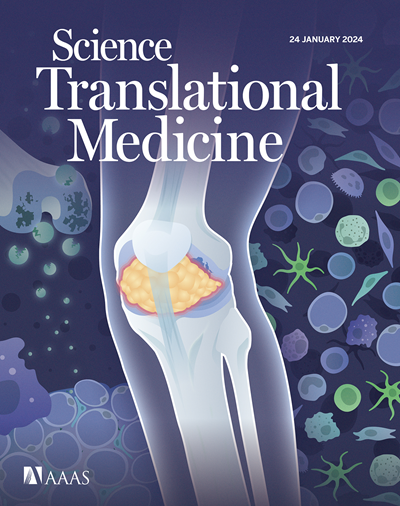Adenovirus and mRNA vaccines as well as mucosal boosting improve protective efficacy against influenza virus challenge in macaques
IF 14.6
1区 医学
Q1 CELL BIOLOGY
引用次数: 0
Abstract
The clinically approved seasonal influenza vaccines provide only 10 to 60% efficacy, necessitating strategies to improve vaccine performance. Here, we explored strategies for improving influenza vaccine efficacy using gene-based vaccines and mucosal boosting strategies in nonhuman primates. All vaccinated cynomolgus macaques were primed with the clinical quadrivalent inactivated virus (QIV) vaccine. We evaluated a rhesus adenovirus (RhAd52) vector delivered by intramuscular or mucosal routes and an mRNA vaccine encoding the hemagglutinin of A/H1N1/Wisconsin/67/2022 delivered intramuscularly as boosts compared with the QIV vaccine delivered intramuscularly and the quadrivalent live-attenuated influenza virus (LAIV) vaccine delivered intranasally. Boosting with RhAd52 and mRNA vaccines induced more robust humoral and cellular immune responses than the clinically approved vaccines and provided improved protective efficacy against a high-dose homologous challenge with A/H1N1/Wisconsin/67/2022. The RhAd52 vaccine delivered by the intratracheal route elicited robust mucosal antibody and T cell responses and provided optimal protection in the upper and lower respiratory tracts. Both peripheral and mucosal antibody responses, as well as mucosal T cell responses, correlated with protection against viral loads. Altogether, this study defines strategies for improving H1N1 seasonal influenza vaccine efficacy by using gene-based vaccines and by optimizing mucosal immunity.

腺病毒和mRNA疫苗以及粘膜增强可提高猕猴对流感病毒攻击的保护效果
临床批准的季节性流感疫苗仅提供10%至60%的效力,因此需要采取措施提高疫苗的性能。在这里,我们探索了在非人类灵长类动物中使用基于基因的疫苗和粘膜增强策略来提高流感疫苗效力的策略。所有接种食蟹猴均接种了临床四价灭活病毒(QIV)疫苗。我们评估了通过肌肉或粘膜途径递送的一种猕猴腺病毒(RhAd52)载体和一种编码a /H1N1/Wisconsin/67/2022血凝素的mRNA疫苗作为增强剂,与肌肉递送的QIV疫苗和鼻内递送的四价减毒流感病毒(LAIV)疫苗进行了比较。与临床批准的疫苗相比,使用RhAd52和mRNA疫苗增强可诱导更强的体液和细胞免疫应答,并可提高对a /H1N1/Wisconsin/67/2022病毒高剂量同源攻击的保护效果。经气管内途径给药的RhAd52疫苗可引起强大的粘膜抗体和T细胞反应,并在上呼吸道和下呼吸道提供最佳保护。外周和粘膜抗体反应,以及粘膜T细胞反应,都与病毒载量的保护相关。总之,本研究确定了通过使用基于基因的疫苗和优化粘膜免疫来提高H1N1季节性流感疫苗效力的策略。
本文章由计算机程序翻译,如有差异,请以英文原文为准。
求助全文
约1分钟内获得全文
求助全文
来源期刊

Science Translational Medicine
CELL BIOLOGY-MEDICINE, RESEARCH & EXPERIMENTAL
CiteScore
26.70
自引率
1.20%
发文量
309
审稿时长
1.7 months
期刊介绍:
Science Translational Medicine is an online journal that focuses on publishing research at the intersection of science, engineering, and medicine. The goal of the journal is to promote human health by providing a platform for researchers from various disciplines to communicate their latest advancements in biomedical, translational, and clinical research.
The journal aims to address the slow translation of scientific knowledge into effective treatments and health measures. It publishes articles that fill the knowledge gaps between preclinical research and medical applications, with a focus on accelerating the translation of knowledge into new ways of preventing, diagnosing, and treating human diseases.
The scope of Science Translational Medicine includes various areas such as cardiovascular disease, immunology/vaccines, metabolism/diabetes/obesity, neuroscience/neurology/psychiatry, cancer, infectious diseases, policy, behavior, bioengineering, chemical genomics/drug discovery, imaging, applied physical sciences, medical nanotechnology, drug delivery, biomarkers, gene therapy/regenerative medicine, toxicology and pharmacokinetics, data mining, cell culture, animal and human studies, medical informatics, and other interdisciplinary approaches to medicine.
The target audience of the journal includes researchers and management in academia, government, and the biotechnology and pharmaceutical industries. It is also relevant to physician scientists, regulators, policy makers, investors, business developers, and funding agencies.
 求助内容:
求助内容: 应助结果提醒方式:
应助结果提醒方式:


